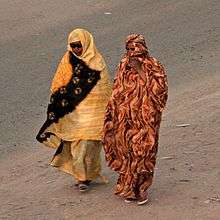Women in Mauritania
Issues impacting Women in Mauritanian society include female genital mutilation,[4] child marriage,[5] and polygamy.[6]
 Women in Atar, Mauritania, 2006 | |
| Gender Inequality Index | |
|---|---|
| Value | 0.643 (2012) |
| Rank | 139th |
| Maternal mortality (per 100,000) | 510 (2010) |
| Women in parliament | 25% (2017)[1] |
| Females over 25 with secondary education | 8.0% (2010) |
| Women in labour force | 32% (2017)[2] |
| Global Gender Gap Index[3] | |
| Value | 0.607 (2018) |
| Rank | 136th out of 149 |
The practice of Leblouh (Arabic: البلوح, romanized: lə-blūḥ) is the practice of force-feeding girls from as young as five, through to teenagers, in Mauritania, Western Sahara, and southern Morocco, where obesity is traditionally regarded as being desirable.[7][8][9]
Older women called "fatteners" force the young girls to consume enormous quantities of food and liquid,[10] inflicting pain on them if they do not eat and drink. One way of inflicting pain is to pinch a limb between two sticks. A six-year-old might typically be forced to drink 20 litres (4.4 imp gal; 5.3 US gal) of camel's milk, and eat two kilos of pounded millet mixed with two cups of butter, every day. Although the practice is abusive, mothers claim there is no other way to secure a good future for their children.[10][11]
The practice goes back to the 11th century, and has been reported to have made a significant comeback in Mauritania after a military junta took over Mauritania in 2008.[10]
Demographics
As of July 2016, the estimated population of Mauritania is 3,677,293 people. The median age of Mauritanian women is 21.4 years. Life expectancy at birth is 65.4 years. [12] The ethnic groups are: black Moors 40%, white Moors 30%, sub-Saharan Mauritanians 30%.[13] Almost all the population practices Islam (see Religion in Mauritania). Urbanization is 53.7%.[14]
Education

Education in Mauritania was strongly influenced by the French educational system. Girls' education is still valued less the boys', and women's literacy rate (age 15 and over) is lower than that of men: in 2015, the female literacy rate was 41.6%, compared to the male rate of 62.6%.[15]
Women's rights
Child marriage
In 2017, 37% of girls in Mauritania were married before the 18 years old. 14% of girls are married before they turn 15.[16]
Polygamy
Polygamy is legal in Mauritania.[6] A man can marry up to four women, but must obtain the consent of his existing wife/wives first. Polygamy is common within the Afro-Mauritanian and Berber Moorish population, occurring less frequently among the Arab Moorish population.[6] A 2007 MICS3 reports that 10.7% of women aged 15-49 are in a polygamous union.[6]
Female genital mutilation

Female genital mutilation is prevalent in Mauritania.[17] 71% of all women aged between 15 and 49 had undergone FGM in 2001. A 2007 demographic cluster study found no change in FGM prevalence rate in Mauritania.[18][4] Type II FGM is most frequent. About 57% of Mauritania women believe FGM is a religious requirement.[19]
Mauritania is 99% Muslim. The FGM prevalence rate varies by ethnic groups: 92% of Soninke women are cut, and about 70% of Fulbe and Moorish women. 28% of Wolof women have undergone FGM.[4] Mauritania has consented to international charters such as CEDAW as well as Africa's Maputo Protocol. Ordonnance n°2005-015 on child protection restricts FGM.[20][21]
Force feeding
Leblouh is the practice of force-feeding girls from as young as five, through to teenagers, in Mauritania, Western Sahara, and southern Morocco, where obesity is traditionally regarded as being desirable.[22][23][24] Especially prevalent in rural areas and having its roots in Tuareg[25] tradition, leblouh is practiced to increase chances of marriage in a society where high body volume used to be a sign of wealth. The synonym gavage comes from the French term for the force-feeding of geese to produce foie gras.
The practice goes back to the 11th century, and has been reported to have made a significant comeback in Mauritania after a military junta took over Mauritania in 2008.[10]
Slavery
.jpg)
Women who descend from slaves experience significant hardship in Mauritania. Slavery has been called "deeply rooted" in the structure of Mauritania, and "closely tied" to the ethnic composition of the country.[26]
In 1905, an end of slavery in Mauritania was declared by the colonial French administration but the vastness of Mauritania mostly gave the law very few successes.[27] In 1981, Mauritania became the last country in the world to abolish slavery,[28] when a presidential decree abolished the practice. However, no criminal laws were passed to enforce the ban.[28][29][30] In 2007, "under international pressure", the government passed a law allowing slaveholders to be prosecuted.[28]
References
![]()
- https://data.worldbank.org/indicator/SG.GEN.PARL.ZS
- https://data.worldbank.org/indicator/SL.TLF.ACTI.FE.ZS
- "The Global Gender Gap Report 2018" (PDF). World Economic Forum. pp. 10–11.
- Female Genital Mutilation in Mauritania Archived 2013-10-03 at the Wayback Machine Federal Ministry of Economic Cooperation and Development, Germany (September 2011)
- Chata Malé; Quentin Wodon (March 2016), BASIC PROFILE OF CHILD MARRIAGE IN MAURITANIA (PDF), World Bank Group
- http://www.genderindex.org/country/mauritania#_ftn17
- Popenoe, Rebecca. 2004. Feeding Desire: Fatness, Beauty, and Sexuality among a Saharan People. New York: Routledge. ISBN 978-0415280969.
- De mujeres abundantemente hermosas (Abundantly beautiful women)
- LaFRANIERE, SHARON. In Mauritania, Seeking to End an Overfed Ideal, The New York Times, published on July 4, 2007. Accessed on June 30, 2011.
- "Girls as young as 5 and as old as 19 had to drink up to five gallons of fat-rich camel’s or cow’s milk daily, aiming for silvery stretch marks on their upper arms. If a girl refused or vomited, the village weight-gain specialist might squeeze her foot between sticks, pull her ear, pinch her inner thigh, bend her finger backward or force her to drink her own vomit. In extreme cases, girls die, due to a burst stomach. The practice was known as gavage, a French term for force-feeding geese to obtain foie gras."
- Smith, Alex Duval. Girls being force-fed for marriage as junta revives fattening farms, The Observer, March 1, 2009.
- Young Mauritanians reject forced fattening, Al Arabiya, February 24, 2009.
- "Mauritania Demographics Profile 2017". www.indexmundi.com. Retrieved 2017-11-16.
- https://www.cia.gov/library/publications/the-world-factbook/geos/mr.html
- https://www.cia.gov/library/publications/the-world-factbook/geos/mr.html
- https://www.cia.gov/library/publications/the-world-factbook/fields/2103.html
- "Child marriage around the world: MAURITANIA", Girls Not Brides
- "FGC Prevalence Rates Diagram", African Women's Health Center, Brigham and Women's Hospital, Harvard Medical School, accessed 7 September 2011.
- LEGISLATION TO ADDRESS THE ISSUE OF FEMALE GENITAL MUTILATION (FGM) Berhane Ras-Work, United Nations (May 21, 2009)
- Female Genital Mutilation/Cutting UNICEF, (July 2013)
- http://www.africanchildforum.org/clr/Legislation%20Per%20Country/Mauritania/mauritania_childjustice_2005_fr.pdf
- "Archived copy" (PDF). Archived from the original (PDF) on 2014-08-19. Retrieved 2018-08-08.CS1 maint: archived copy as title (link)
- Popenoe, Rebecca. 2004. Feeding Desire: Fatness, Beauty, and Sexuality among a Saharan People. New York: Routledge. ISBN 978-0415280969.
- De mujeres abundantemente hermosas (Abundantly beautiful women)
- LaFRANIERE, SHARON. In Mauritania, Seeking to End an Overfed Ideal, The New York Times, published on July 4, 2007. Accessed on June 30, 2011.
- "Girls as young as 5 and as old as 19 had to drink up to five gallons of fat-rich camel’s or cow’s milk daily, aiming for silvery stretch marks on their upper arms. If a girl refused or vomited, the village weight-gain specialist might squeeze her foot between sticks, pull her ear, pinch her inner thigh, bend her finger backward or force her to drink her own vomit. In extreme cases, girls die, due to a burst stomach. The practice was known as gavage, a French term for force-feeding geese to obtain foie gras."
- Encyclopedie Berbere: Gavage
- Ghanem, Omar (21 August 2007). "Slavery in Mauritania Emancipating the Free". onislam.net. Archived from the original on 28 October 2014. Retrieved 28 October 2014.CS1 maint: BOT: original-url status unknown (link)
- John D. Sutter (March 2012). "Slavery's Last Stronghold". CNN. Retrieved 25 June 2017.
- Okeowo, Alexis (8 September 2014). "Freedom Fighter: A slaving society and an abolitionist's crusade". The New Yorker. Retrieved 16 October 2014.
- "Mauritanian MPs pass slavery law". BBC News. 9 August 2007. Retrieved 2010-05-23.
- Corrigan, Terence (6 September 2007). "Mauritania: Country Made Slavery Illegal Last Month". The East African Standard. Archived from the original on 21 November 2010. Retrieved 21 January 2008.
| Wikimedia Commons has media related to Women of Mauritania. |
